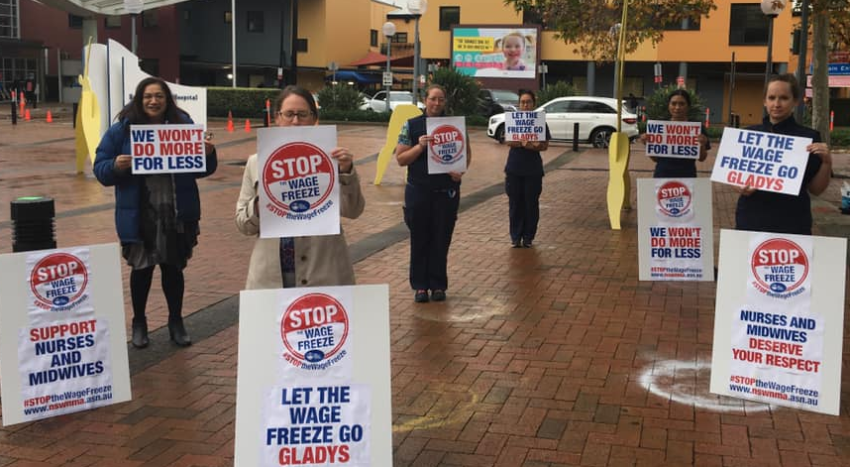
As nurses rallied outside New South Wales parliament, the Legislative Council decided on June 2 to reject the state government’s attempt to impose a 12-month pay freeze on 400,000 public servants, including nurses and paramedics.
It was a major defeat for the government. Only Christian Democrat Fred Nile supported the pay freeze push. Labor and the Greens’ disallowance motion was supported by independent Justin Field, Animal Justice, Shooters, Fishers and Farmers and Pauline Hanson's One Nation to block the government’s regulation.
The disallowance motion was carried 22 to 15. This was only the sixth time in nine years such a resolution has successfully passed the council.
Treasurer Dominic Perrottet said he was pursuing the wage freeze with the NSW Industrial Relations Commission (IRC). The Coalition will need to pressure the IRC to overturn an already agreed 2.5% annual wage rise for the coming year.
Paramedics were the first to launch industrial action over the wage freeze move, refusing to bill patients for ambulance services from June 1. Australian Paramedics Association NSW president Chris Kastelan said the billing bans were designed to “send the premier a message”.
Nurses, midwives and other public sector workers rallied outside parliament as the disallowance motion was being debated. Skye Romer, from the NSW Nurses and Midwives’ Association (NSWNMA), told the ABC that nurses and midwives “have put everybody else’s health and safety ahead of our own” in the COVID-19 crisis. “We will not accept a pay freeze, and we will definitely not accept a pay cut,” she said.
Several unions had already rejected the treasurer’s offer of a $1000 bonus for frontline workers, describing the money as “lousy”.
After several weeks of their social media campaign, nursing unionists surrounded parliament while more than 60 branches participated in statewide actions.
NSWNMA general secretary Brett Holmes said the wage freeze idea was “cruel” and that the government needed to be thanking front line workers “who have persevered non-stop to get us through the COVID-19 pandemic, the summer bushfires or the crippling drought”.
The NSW government claims the pay freeze will save taxpayers $3 billion over four years and help create thousands of new jobs.
But a new report by The Australia Institute said this is questionable.
“The available data does not support the assertion that switching public spending away from public sector pay and towards capital expenditure would lead to an increase in employment in NSW,” said Richard Denniss, Matt Grudnoff and David Richardson.
Reducing the spending power of some Australians will hurt the economy, they pointed out.
“While reducing the disposable income of NSW public servants will not result in a direct reduction in employment, it will likely have a significant impact on the level of spending NSW public sector employees and, in turn, on the level of demand and employment in the NSW economy,” they said.
Meanwhile, a webinar organised on May 28 by the NSWNMA heard from Irish Nurses and Midwives Organisation general secretary Phil Ni Sheaghdha, economist and director of the Centre for Future Work Jim Stanford and Holmes.
Sheaghdha said it had taken 12 years to claw back lost wages and conditions from the 2008 global financial crisis which decimated the Irish public health system. She urged NSW nurses and midwives to resist all forms of austerity. “A pay freeze is the first stage of a pay cut”, she said.
Sheaghdha described the shocking working conditions when nurses had to ensure up to 50% wage cuts, and public servants’ wages were cut by 10-12%. It led to a severe shortage of nurses in Ireland forcing nurses to migrate to other countries, such as England and Australia, to survive.
She pointed to research showing a direct link between nurses’ low wages and reduced working conditions with poorer outcomes for patients. For instance, when the skill mix was weighted towards non-skilled health workers, it led to an increase in deaths in age care, she said. “Ramping” in hospitals’ Emergency Departments (in which paramedics are forced to look after patients because the Emergency Department is overburdened) meant patients were not seen quickly. This also caused a rise in preventable deaths.
Stanford debunked the economic myths to support a wage freeze, describing it as an economically destructive action and also morally wrong. He warned that wage freezes, really a wage cut, quickly turns a recession into a depression.
It will reduce the governments’ tax revenue base too, he said, given that the NSW state government is the country’s biggest employer.
The idea that a wage freeze is a temporary measure not true. Stanford explained that one year of a wage freeze affects a worker’s income over a lifetime, and the loss of income would amount to thousands of dollars lost.
Stanford said that a wage freeze in one sector would spread to all sectors, both public and private, and lead to job cuts and a greatly reduced standard of living for workers.
Holmes pointed out that nurses had stood tall against COVID-19, and will continue to turn up to work to keep people alive. He reported that the NSWNMA had gained support from the cross bench, the Greens and Labor Party in the Legislative Council to oppose the bill but asked members to stay vigilant as the battle would have to continue.